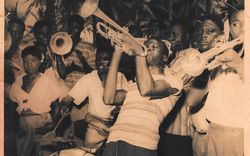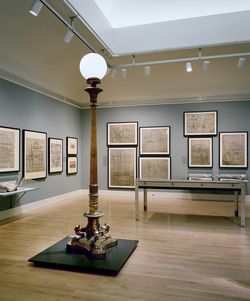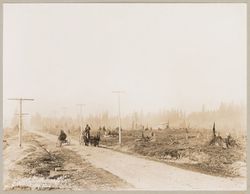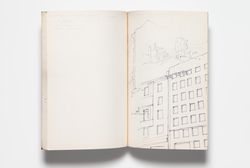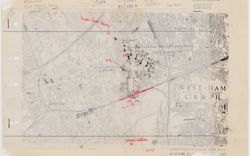articles
Le rythme de la modernisation
Dele Adeyemo relit la production de l’espace d’un Ghana en voie de modernisation à travers le highlife
Actions:
L’exposition se penche sur la période durant laquelle Montréal, cité marchande du XIXe siècle, se transforme et devient métropole du Canada. Y sont mis en lumière les éléments qui ont fait de Montréal une ville de grande influence aux plans politique, social et économique ainsi que le caractère unique de son architecture. Parmi les quelque 350 pièces regroupées, on(...)
Salles principales
18 mars 1998 au 24 mai 1998
Montréal métropole, 1880-1930
Actions:
Description:
L’exposition se penche sur la période durant laquelle Montréal, cité marchande du XIXe siècle, se transforme et devient métropole du Canada. Y sont mis en lumière les éléments qui ont fait de Montréal une ville de grande influence aux plans politique, social et économique ainsi que le caractère unique de son architecture. Parmi les quelque 350 pièces regroupées, on(...)
Salles principales
Maison Shaughnessy Mot(s)-clé(s):
chercheur en résidence 2022, séminaire, recherche, Desirée Valadares, infrastructure, chemin de fer, autoroute, histoire coloniale
10 novembre 2022, 18h
Maison Shaughnessy Mot(s)-clé(s):
chercheur en résidence 2022, séminaire, recherche, Desirée Valadares, infrastructure, chemin de fer, autoroute, histoire coloniale
Le chercheur en résidence Gregorio Carboni Maestri présente sa recherche. Des années 1930 à la fin des années 1980, l’architecture portugaise s’est construite sur une relation frustrante avec la modernité, et sur un dialogue crucial avec l’Italie. Ce séminaire portera sur la façon dont l’architecture portugaise a observé les modèles italiens et y a réagi, notamment le(...)
Maison Shaughnessy Mot(s)-clé(s):
Gregorio Carboni Maestri, chercheur en résidence, Portugal, Tendenza
3 août 2017, 18h
Séminaire de chercheur en résidence : Gregorio Carboni Maestri
Actions:
Description:
Le chercheur en résidence Gregorio Carboni Maestri présente sa recherche. Des années 1930 à la fin des années 1980, l’architecture portugaise s’est construite sur une relation frustrante avec la modernité, et sur un dialogue crucial avec l’Italie. Ce séminaire portera sur la façon dont l’architecture portugaise a observé les modèles italiens et y a réagi, notamment le(...)
Maison Shaughnessy Mot(s)-clé(s):
Gregorio Carboni Maestri, chercheur en résidence, Portugal, Tendenza
Projet
AP178.S1.1963.PR01
Description:
This project series documents the Casa Rui Feijó house in Caminha, Portugal. While the records were held in the office’s archives this project was assigned the number 11/60. In the past the office identified the project as number 108. The office assigned the date 1963 to this project. Drawings suggest an L-shaped, single-storey building. This project was a vacation house with three bedrooms, a bathroom, kitchen, living-room, service bedroom, exterior annex, garage, lounge and terrace. The project was developed for the client Rui Feijó, however work on the project was halted in its prelimary phase. Siza used this prelimiary work to develop his submission for his CODA (Concurso para a Obtenção do Diploma de Arquitecto), which is also documented in this fonds (see project series AP178.S1.1965.PR01). Documenting this project are sketches, plans, elevations and details, as well as correspondence with the city of Caminha and competition documentation.
1963-1965
Casa Rui Feijó [Rui Feijó house], Moledo do Minho, Caminha, Portugal (1963)
Actions:
AP178.S1.1963.PR01
Description:
This project series documents the Casa Rui Feijó house in Caminha, Portugal. While the records were held in the office’s archives this project was assigned the number 11/60. In the past the office identified the project as number 108. The office assigned the date 1963 to this project. Drawings suggest an L-shaped, single-storey building. This project was a vacation house with three bedrooms, a bathroom, kitchen, living-room, service bedroom, exterior annex, garage, lounge and terrace. The project was developed for the client Rui Feijó, however work on the project was halted in its prelimary phase. Siza used this prelimiary work to develop his submission for his CODA (Concurso para a Obtenção do Diploma de Arquitecto), which is also documented in this fonds (see project series AP178.S1.1965.PR01). Documenting this project are sketches, plans, elevations and details, as well as correspondence with the city of Caminha and competition documentation.
Project
1963-1965
Projet
AP178.S1.1993.PR07
Description:
This project series documents the Faculdade de Ciências da Informação in Santiago de Compostela, Spain. While the records were held in the office’s archives this project was assigned the number 41/90. The office assigned the date 1993 to this project. The Faculty is located on the north campus of the University of Santiago de Compostela, on the Burgo das Nacións Avenue. The building is divided in two sections, one with three stories and the other with two stories. The upper floor is for nine amphitheater classrooms and the lower floors are for the media laboratories and studios. The building also includes an atrium, a library, studios, and media laboratories. The project was realized and is now named the Facultad de Ciencias de la Comunicación. Documenting this project are sketches, studies, working drawings, structural drawings, technical drawings, and mechanical drawings. Textual material includes project documentation and correspondence. Photographic material documents the models, construction work, the built project, and furniture.
1993-2000
Faculdade de Ciências da Informação [Faculty of Communication Sciences], Santiago de Compostela, Spain (1993)
Actions:
AP178.S1.1993.PR07
Description:
This project series documents the Faculdade de Ciências da Informação in Santiago de Compostela, Spain. While the records were held in the office’s archives this project was assigned the number 41/90. The office assigned the date 1993 to this project. The Faculty is located on the north campus of the University of Santiago de Compostela, on the Burgo das Nacións Avenue. The building is divided in two sections, one with three stories and the other with two stories. The upper floor is for nine amphitheater classrooms and the lower floors are for the media laboratories and studios. The building also includes an atrium, a library, studios, and media laboratories. The project was realized and is now named the Facultad de Ciencias de la Comunicación. Documenting this project are sketches, studies, working drawings, structural drawings, technical drawings, and mechanical drawings. Textual material includes project documentation and correspondence. Photographic material documents the models, construction work, the built project, and furniture.
Project
1993-2000
articles
25 septembre 2023
Dangereux, immoral, en avance sur son temps
Notes sur l'histoire du projet le Fun Palace
Actions:
Projet
AP178.S1.2005.PR05
Description:
This project series documents the Instalação na Exposição "Entrez Lentement" per il Salone del Mobile in Milan. While the records were held in the office’s archives this installation was assigned the label "outro" in place of the usual project number, to designate that it was work done for an exhibition. The office assigned the date 2005 for this installation. This project consisted of an exhibition installation at the 2005 edition of the famed Salone del Mobile Milano (Milan Furniture Fair). The Salone del Mobile exhibition, entitled "Entrez Lentement," invited eight architects to build installations related to famous architectural projects. Siza's work spoke to Oscar Neimeyer's personal home, Casa das Canoas in Rio de Janeiro. He designed two organic white forms and a curved yellow chaise lounge that related to the curved forms present in the original home. Documenting this project are sketches, a plan, and the exhibition space layout of the Salone. These materials date from 2004.
2004
Instalação na Exposição "Entrez Lentement" per il Salone del Mobile [Installation for the "Entrez Lentement" exhibition at the Salone de Mobile], Milan (2005)
Actions:
AP178.S1.2005.PR05
Description:
This project series documents the Instalação na Exposição "Entrez Lentement" per il Salone del Mobile in Milan. While the records were held in the office’s archives this installation was assigned the label "outro" in place of the usual project number, to designate that it was work done for an exhibition. The office assigned the date 2005 for this installation. This project consisted of an exhibition installation at the 2005 edition of the famed Salone del Mobile Milano (Milan Furniture Fair). The Salone del Mobile exhibition, entitled "Entrez Lentement," invited eight architects to build installations related to famous architectural projects. Siza's work spoke to Oscar Neimeyer's personal home, Casa das Canoas in Rio de Janeiro. He designed two organic white forms and a curved yellow chaise lounge that related to the curved forms present in the original home. Documenting this project are sketches, a plan, and the exhibition space layout of the Salone. These materials date from 2004.
Project
2004
Sous-série
AP178.S1.1998.PR03.SS3
Description:
This project subseries documents the Casa Pátio building attached to the Edifício Zaida in Granada, Spain. While the records were held in the office’s archives this project was assigned the number 98/90 C. The office assigned the dates 1998-2006 to this project subseries. This was phase 2 of the larger project to redevelop three parcels of land that faced the Plaza Puerta Real. This part of the larger Zaida building, an old courtyard house, was located between the Zaida building and neighbouring buildings. The exterior was reimagined in the style of the new Zaida building, but it was visually separated through its unique window arrangement. Documenting this project subseries are drawings, textual records and photographic materials dating from 2003-2005. The textual records include correspondence and documentation on the design of furniture, accessories, artwork and the mechanical and techinical aspects of the buildings. The drawings include structural, mechanical and technical drawings, as well as details. The photographic materials show the building's construction and the built project.
2003-2005
Edifício Zaida, Casa Pátio [Zaida building, Courtyard House], Granada, Spain (1998-2006)
Actions:
AP178.S1.1998.PR03.SS3
Description:
This project subseries documents the Casa Pátio building attached to the Edifício Zaida in Granada, Spain. While the records were held in the office’s archives this project was assigned the number 98/90 C. The office assigned the dates 1998-2006 to this project subseries. This was phase 2 of the larger project to redevelop three parcels of land that faced the Plaza Puerta Real. This part of the larger Zaida building, an old courtyard house, was located between the Zaida building and neighbouring buildings. The exterior was reimagined in the style of the new Zaida building, but it was visually separated through its unique window arrangement. Documenting this project subseries are drawings, textual records and photographic materials dating from 2003-2005. The textual records include correspondence and documentation on the design of furniture, accessories, artwork and the mechanical and techinical aspects of the buildings. The drawings include structural, mechanical and technical drawings, as well as details. The photographic materials show the building's construction and the built project.
Project
2003-2005
Sous-série
AP178.S1.2002.PR06.SS2
Description:
This project subseries documents the Piscina Pública in Pedras Salgadas, Portugal. While the records were held in the office’s archives this project was assigned the number 50/00. The office assigned the dates 2008-2010 to this project. This project consisted of two outdoor public pools for the Pedras Salgadas Spa and Nature Park. One large pool was built for adults and a smaller children's pool sat diagonally from it. A small building that contained a bar was also built next to the pools. The project was realized. This project subseries is documented through drawings, photographic materials and textual records dating from 2007-2010. The drawings are mostly printed reprographic copies of CAD drawings, many of which have annotations, showing plans and details. The photographic materials, which are printed digital photos, show the site and construction. The textual records include technical documentation for the water, fire and gas systems, structural and electrical documentation, supplier catalogues, budgets, specifications and correspondence.
2007-2010
Piscina Pública [Public swimming pool], Pedras Salgadas, Portugal (2008-2010)
Actions:
AP178.S1.2002.PR06.SS2
Description:
This project subseries documents the Piscina Pública in Pedras Salgadas, Portugal. While the records were held in the office’s archives this project was assigned the number 50/00. The office assigned the dates 2008-2010 to this project. This project consisted of two outdoor public pools for the Pedras Salgadas Spa and Nature Park. One large pool was built for adults and a smaller children's pool sat diagonally from it. A small building that contained a bar was also built next to the pools. The project was realized. This project subseries is documented through drawings, photographic materials and textual records dating from 2007-2010. The drawings are mostly printed reprographic copies of CAD drawings, many of which have annotations, showing plans and details. The photographic materials, which are printed digital photos, show the site and construction. The textual records include technical documentation for the water, fire and gas systems, structural and electrical documentation, supplier catalogues, budgets, specifications and correspondence.
Project
2007-2010
